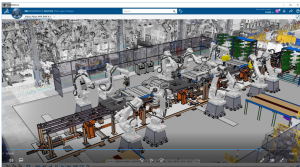As manufacturing continues to push forward facing new realities and considerable disruption, the need to quickly address a very dynamic and evolving shop floor environment has never been clearer. Join Dassault Systèmes and digital scanning experts from NavVis on Thursday, November 5th at 2:00 p.m. EST for a live webinar hosted by Industry Week, called Leveraging Virtual Technology to Accelerate Manufacturing Safety & Production. Learn how the “virtual twin experience” allows manufacturers to visualize and optimize the factory during disruptions, and how to establish a full factory scan to create a working virtual twin for a facility.
If your plans for digital transformation don’t include the shop floor, you need to rethink your plans. Manufacturers must be able to address safety, production, and quality issues by combining the virtual and the real (V+R). Virtual operations become possible when a company extends the virtual twin experience to the planning and use of the factory floor.
We had the chance to catch up with Evan McPhee, who heads North American operations for Munich-based NavVis, to learn more.
Q: What is the basic value proposition that brings to manufacturing?
Evan McPhee (EM): Our users get more value out of their buildings and facilities by making them part of the virtual twin experience. When you can manage and operate facilities digitally, it is possible to decrease downtime and improve utilization. Both of these outcomes drive costs  down.
down.
Q: Who are the target users of the data NavVis gathers?
EM: Anyone in the organization who does building documentation, such as for safety or insurance, can use this data. Other departments that gain value include facilities management, plant planning and logistics, visitor services, and anyone who does ongoing monitoring of plant operations.
Q: What are the key solutions that come out of having factory facilities scanned?
EM: It becomes possible to run virtual simulation of many plant operations. You could test air quality concerns, or run safety simulations. Managers can test social distancing scenarios on the computer instead of through physical trial and error — which would create a social distancing problem in and of itself. As product demand shifts over time, companies can use the virtual factory to access production scenarios. They can also visualize and validate new workflows, new lines, and test for optimal production scenarios.

Q: How do you do the initial scanning? Is it invasive? Does it require shutdown?
EM: We utilize our own custom wearable scanning device; we do not use the tripod approach to scanning. We can be in and out quickly, with minimal disruption. We estimate our approach is ten times faster than tripod scanning. We capture everything, we get it in color, and can create good photos from the scan data. In the time competing scanning services scan an alcove, we can do the entire hall.
We also use our own software, the NavVis Viewer. It makes the raw scan data useful to experts — like Dassault Systèmes DELMIA users — and to non-experts like most of the factory team. We see our software as a great complement to DELMIA, making the data accessible to both technical and non-technical employees. It is easy to measure a distance in our viewer, for example. Sometimes that is the only reason someone might turn to the data, and they don’t need access to the DELMIA service or learn how to use it.
Q: The files created by scanners can be huge. How does NavVis and DELMIA handle the sheer size of the data?
EM: Point clouds can be tens of gigs in size. We make the data more manageable in two ways. First, we decimate, which means to intelligently reduce the density of data. The other is with our Crop and Save feature. It is easy for a non-technical user to find the one machine they need to know about, and save it for use separate from the master data file. It is a simple drag-and-drop procedure.
Q: You use walk-about scanners, not tripods. Why?
EM: It is about using the best tool for the job. Tripods are amazing, and the scanning devices that require tripods collect extremely dense data, generally around 1 millimeter resolution. These devices are expensive and slow. Our wearable scanners have an accuracy of between seven and eight millimeters, which is good enough for creating virtual factory data. We can capture large spaces rapidly. Scanning at 7 millimeters instead of 1 millimeter also means we create small data files.
There is an order-of-magnitude price difference between the tripod scanners and our wearables. Which means we compete on a cost basis, but it is really about the specific use case. We think there is room for much broader use of scan data in factories, and in construction where we also compete. We think we can grow this market by offering affordable and useful scan data. Our price and performance lowers barriers to entry and use.
##
